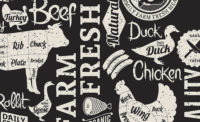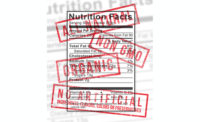On Dec. 1, 2016, the Food Safety and Inspection Service (FSIS) released a pre-publication version of its long-awaited proposed rule “Revision of the Nutrition Facts Labels for Meat and Poultry Products and Updating Certain Reference Amounts Customarily Consumed.” The proposed rule is intended to harmonize FSIS’ nutrition facts labeling requirements with the final nutrition labeling regulations published by the Food and Drug Administration (FDA) in May 2016. The FDA’s final regulations made substantial changes to both the appearance and content of nutrition facts labels, updated the Reference Amounts Customarily Consumed (RACCs) for certain types of products, redefined single-serving containers and required dual-column labeling for certain containers.
FSIS’ proposed rule essentially mirrors FDA’s final nutrition regulations. If finalized, it would also consolidate the meat and poultry labeling requirements in a new part, Proposed 9 C.F.R. Part 413. Highlights include the following:
• Format and appearance changes to the nutrients facts panel: Among other changes, the proposed rule would increase the prominence of the font for calories, serving size and the serving size per container declaration. It would also switch the order of the serving size and servings per container declarations, requiring the latter to be declared as “X servings per container.” The absolute quantity of vitamins and minerals would need to be listed in addition to percent daily values, and the footnote table listing the Daily Recommended Values (DRV) for 2,000- and 2,500-calorie diets would be removed and replaced with a footnote defining the “% Daily Value.”
• Changes in required and voluntary nutrients: The proposed rule would update the list of nutrients required or permitted to be declared in the nutrition facts panel. One of the most significant and controversial proposed changes is the requirement that “added sugars” be declared on the panel. “Added sugars” would be defined as “sugars that are either added during the processing of foods or are packaged as such and include sugars (free, mono- and disaccharides), sugars from syrups, honey and fruit juice concentrates.” Another significant change relates to trans fat. Although FSIS currently allows the amount of trans fat to be voluntarily declared on the panel, the proposed rule would now mandate this declaration. Other significant changes include:
• “Calories from fat” can no longer appear in the nutrition facts panel;
• “Calories from saturated fat” can be declared voluntarily;
• Vitamin D, calcium, iron and potassium would have to be declared and other listed vitamins and minerals could be voluntarily declared;
• Flouride could be voluntarily declared, with mandatory declaration required if a claim is made; and
• Dietary fiber would be redefined to include some forms of added non-digestible carbohydrates.
• Changes in DRV and reference daily intake (RDI) values: The proposed rule would revise the DRV for a number of nutrients and the RDI for several vitamins and minerals. Notable changes include:
• The DRV for total fat would be increased from 65 grams to 78 grams;
• The DRV for total carbohydrates would be decreased to 275 grams;
• The DRV for sodium would be reduced from 2,400 mg to 2,300 mg;
• A DRV of 50 g would be established for added sugar for adults and children 4 years of age or older; and
• RDIs would be updated for calcium, copper, folate, iodine, iron, magnesium, niacin, phosphorous, riboflavin, thiamin, zinc, and vitamins A, B6, B12, C, D, and E and established for Vitamin K, selenium, manganese, chromium, molybdenum, chloride and choline.
• RACCs: The proposed rule would update a number of RACCs based on the presence of new products and a better understanding of the realistic portions that are consumed. For example, a new RACC would be established for appetizers/hors d’oeuvres/meat and poultry dips and for chocolate with meat/poultry. Other RACCs that are currently separated by meat or poultry are now combined into one RACC. A complete listing of the new RACCs is set forth in part B of the appendix to the proposed rule.
• Single-serving containers and dual-column labeling: In addition to the above, FSIS proposes to make substantial changes regarding RACCs for foods in containers that are likely to be consumed in one setting. Under the proposed rule, if a container contains more than 150 percent and less than 200 percent of a given RACC, it would be listed as containing one serving, regardless of the RACC of the products. Moreover, if a package contains at least 200 percent and up to and including 300 percent of a given RACC, the package would be required to contain dual-column labels that provide both nutrition information on a per serving and per package basis. Dual-column information would not be required on packages containing more than 300 percent of a product’s RACC.
• Recordkeeping: The proposed rule would require recordkeeping to substantiate declarations regarding dietary fiber, soluble fiber, insoluble fiber, added sugars, tocopherol, folate and folic acid. The records must be kept for two years and be made available to FSIS upon request.
Comments on the proposed rule are due within 60 days of publication in the Federal Register. NP






Report Abusive Comment